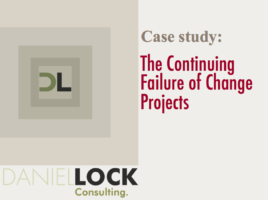Most failing change projects do so because of the lack of attention paid to the basic principles of change management.
When organizations need to change, leaders cannot simply click their fingers and expect that change to take place.
The reasons and benefits of change may be obvious to project sponsors, change leaders, and the board of directors – hence the decision to make change – but that doesn’t mean they will be clear to all.
Why do strategic change projects fail?
Change is unsettling, with people required to alter the way they have done things for years. There may be job losses, revision of working practices, new processes, procedures, and systems, and even new managers for team members to get used to.
It is that phrase which, perhaps, sums up the problem that most change leaders face: People need to ‘become used to’ change.
Taxing times of change
 Consider this large scale project in the UK and the progression of which may serve as a lesson for governments around the world.
Consider this large scale project in the UK and the progression of which may serve as a lesson for governments around the world.
With the need to cut budget deficits, and reduce the national debt, the government has made public spending and raising taxes priorities.
What better place to see both workings than at the tax-collecting agency, the HMRC.
Back in 2012, the HMRC published its first Digital Strategy. The aim was to change the way it does things internally, and also to change the way that its ‘customers’ interact with it.
The idea is that taxpayers will conduct much more tax related issues online rather than on paper. This cuts waste, reduces processing times, makes for more accurate calculations, and, of course, will reduce job numbers at HMRC.
Evidence of failing change management
The HMRC’s change projects have always met with resistance. The department came about through the merger of the Inland Revenue and Customs and Excise in 2005.
Since that time organizational change has been constantly on the agenda. For nearly a decade, change after change has been forced upon the staff. Employee numbers have reduced by nearly 35% from 96,000 to 60,000.
The HMRC’s change leaders understand the need for employee engagement in the process, yet they have felt left out in the cold, unloved and unwanted. Change management’s idea of employee engagement at HMRC was to issue an annual staff survey. In 2010, the response rate was 69%. Only a year later, this rate had fallen to 52%: a clear indication that employees don’t care, and have a total distrust of management.
Does a ‘no-reply’ mean employees are happy?
Employees’ distrust of senior management at HMRC ran so hot that most believe that the lack of response would be taken as a sign of staff happiness at work. This distrust was heightened when the staff survey gave no room for comment and was simply a list of questions with multiple choice answers.
Employee feelings, all of which heightened resistance to change, included:
- Employees saw managers as being people inexperienced and uneducated in the business
- Further, they saw the survey as simply paying lip service, a waste of time that was completely ignored
- They believed management to be making mistakes at almost every turn
- Concerns and suggestions for improvement given to lower level managers would be ignored by senior managers
Simply put, there were so many surveys that employees stopped responding.
Management’s response to the 2011 survey was exactly as most employees expected: another large change initiative, this time the 2012 Digital Strategy.
Failing change management
At the heart of the 2012 Digital Strategy was the desire to move customers to a more automated system. Employees were expected to help this process but given no say in the process of doing so.
Imagine a bar which had been a Maroons stronghold for decades suddenly being bought out and painted in Blues colors. That’s the sort of resistance the forced change at HMRC came up against.
The digital strategy did have some success:
- 200,000 small businesses signed up for digital tax accounts
- 400,000 tax credit customers began renewing claims online
- But these results, from tens of millions of taxpayers, took two years to realize.
A new approach to change management at HMRC
HMRC is promising a new approach from its change leaders toward its change projects. It says that it now has a change management strategy that is fuelled by disengaged staff.
At the Employee Benefits Live 2014 conference, Judy Greevy, deputy director engagement and diversity HMRC, said, ‘A real challenge we have, like a lot of organizations, is really making it possible for people to feel that they actually have a voice in the organization and that people are listening to them.
“We’re going through this whole big change and we’re going to need a lot more skills and different ways of operating, so what we need to do to help people get through this is to make them feel more empowered in terms of what they do in their job, and to enable them to identify ways that things can be done better.”
Change management at HMRC believes that supporting staff and helping them build new skillsets was key. Consequently, staff will:
- Have a minimum of five days of training each year
- A new rewards offering aligned to staff expectations and needs
A new digital change management strategy
Change leaders at HMRC have updated the Digital Strategy. It’s new 2014 version sets out the ‘digital vision’ to all customers (individuals, business, and agents) to give all their own online tax account. The service wants customers to deal with it online.
HMRC’s Chief Digital and Information Officer, Mark Dearnley, has said it will ‘go on listening to what customers are telling us.’ In the strategy document, there is little mention of the staff.
Further, Dearnley said, “So there’s no big fanfare today. It’s business as usual for my teams in our two Digital Centres and elsewhere across HMRC working hard to make our digital vision a reality. This is one more small but important step and I’m really excited about what the future holds.”
Set up for continuing change failure
The HMRC seems to have learned little about its employees or how to manage change over the last decade. Employees, shunning the staff survey, feel they have no voice and no input. The response of change leaders is to provide more training and tinker with its reward system. This new program will be aligned with the new digital strategy.
Meanwhile, the new digital strategy document is unveiled and concentrates 99% on the customer.
Employees, feeling disengaged and underutilized will hear only one sentence of the whole announcement by Dearnley:
“It’s business as usual for my teams in our 2 Digital Centres and elsewhere across HMRC working hard to make our digital vision a reality.”
How taxing are change projects?
In the modern world, employees want to be heard. They want to know that management takes their views seriously.
People at all levels have different views, different fears, and concerns. They also have a wealth of talent and experience, not only of internal workings but also of customers. Ignore them at your peril.
Having read about how the HMRC has tackled change over the last decade, is there anything you would do differently?


